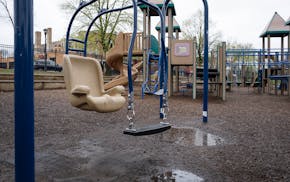In the next few weeks, the Green Jobs Task Force will deliver concrete recommendations relating to the challenges and opportunities Minnesota faces as climate change remakes the economy. The work of the task force has been substantial and very well-documented; browse the published material here. Governor Pawlenty this winter asserted continuing interest in this process, and the task force membership spans across Minnesota's private, public and civic sectors.
The scope of the climate change challenge is immense, and responding to it will transform many aspects of how we live, do business, get around, and how we understand the impact of individual and organization decisions – as well as how we finance those decisions. Moving forward to address climate change is not just a global concern. It is also a critical regional and state undertaking. In economic terms, the private sector as well as the state has a fundamental interest in this issue, and has everything to gain or lose.
The task force recommendations, like much of the conversation at the public policy level, focus on creating and attracting green jobs. In this context, a green job is widely understood to be one in areas such as solar or geothermal equipment manufacturing or biofuels, or in services relating to reduction of energy consumption. These are important priorities, and areas where Minnesota may identify and benefit from growing demand for such products and services.
The forest, not just the trees
There's a still broader opportunity. The region and our state will, like other places, find our competitiveness increasingly hitched to how we handle the environmental costs of the way we operate. For example, as shipping costs increasingly shift volume from trucking cross-country to rail freight, Minnesota's role as a hub will provide a strategic advantage – jobs, reduced distribution costs, capital investment. It will also reduce the emissions per ton of shipping, as material is shipped via rail for long distances and then via truck, as opposed to trucking from start to finish. The jobs created and sustained by activities like freight rail aren't considered green jobs under the existing rubric, but the industry is part of a collection of assets that could help keep Minnesota vital in an economic sense. A green economy won't add substantively to our competitiveness if it's limited to a handful of firms building turbine blades – it needs to represent a broader range of activity.
Homegrown
The green jobs task force report illustrates the public sector's growing interest in supporting and informing the development of a green economy. The public sector's role includes identifying how Minnesota can maximize the expertise and materials we have to offer to the economy of the future; the task force has moved forward in this area.
It makes sense to examine industries expected to mushroom as the cost effectiveness of wind, geothermal and other energy systems continues to improve for commercial and residential uses. Clearly, these industries will be invented and reinvented, grown and expanded in the years to come. An even bigger prospect for Minnesota will be enhancing how organizations in the private and public sectors are able to craft competitive advantage by managing rising fuel costs, and to support entrepreneurs we retain with assets like an educated workforce, quality schools, cultural wealth, and protected natural resources.
Market necessity will shape many future jobs focused on reducing energy consumption and carbon emissions, and the increasingly consequent financial costs. Most of these will be private-sector jobs that fall outside of the current "green jobs" definitions. As the findings of the green jobs task force are presented and recognized for their value, it's a good time to consider how Minnesota can plan to solidify and not erode our strategic position in a different world.
University of Minnesota considers increasing tuition next school year
St. Paul Chamber Orchestra's artistic director Kyu-Young Kim stepping down but staying on
Minnesota Innocence Project seeks records in murder case that hinged on embattled medical examiner's testimony

Minnesota Power agrees to smaller bill increase for customers in settlement

